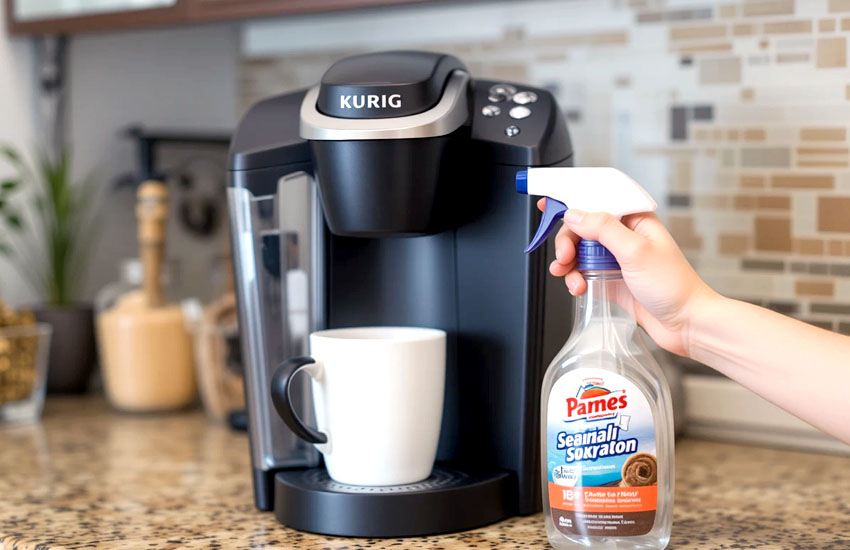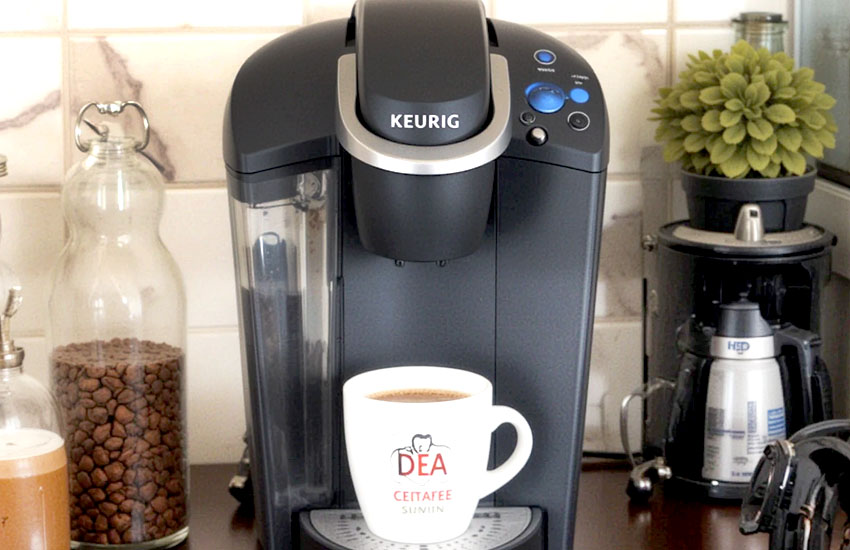Do you love your Keurig but dread the thought of cleaning it? Don't worry, I've got your back! In this ultimate guide, we're going to dive into the 10 easy steps that will make your Keurig sparkle like new. It's easier than you think, and you'll be sipping delicious, fresh coffee in no time!

10 Steps to Clean Your Keurig Coffee Machine
Step 1: Gather Your Supplies for a Smooth Start
Before you dive into cleaning your Keurig, it's important to gather the right supplies. Having everything ready to go will make the whole process smoother and less stressful. You don’t need fancy tools, just some basic items that are already probably lying around in your kitchen. Here's what you'll need:
- Water – Fresh, clean water is key. Avoid using water that’s been sitting around for too long, as it can have a stale taste and doesn't clean as effectively.
- Vinegar – Yes, the humble vinegar! It's one of the best natural cleaners for your Keurig, helping to remove mineral buildup and scale inside the machine.
- Dish Soap – For cleaning the removable parts like the drip tray and K-cup holder.
- A Cloth or Sponge – To wipe the exterior and any other parts that need a gentle scrub.
- Water Filter (Optional) – If you want to prevent buildup in the future, a replacement water filter can be handy.
- Large Bowl or Container – To catch any water or liquid that comes out during the cleaning process.
With all your supplies lined up, you're ready to start the cleaning process! This list of materials will ensure that each step goes smoothly, so grab everything and let's move on to the next step!
Step 2: Unplug the Machine and Remove Parts for Cleaning
Now that you have your supplies, it's time to start cleaning. The first thing you should do is unplug the Keurig. It's always a good idea to cut the power before you begin cleaning, especially when dealing with electrical appliances. Safety first!
Once you've unplugged the machine, start by removing the parts that are easy to clean. Take off the water reservoir, drip tray, and K-cup holder. These are usually the parts that get the most gunky and need a good scrub.
The water reservoir can often accumulate some mold or build-up over time, so it's essential to wash it thoroughly with warm soapy water. Use a sponge or dishcloth to scrub the inside and outside. Don't forget to rinse it thoroughly to avoid any soap residue.
For the K-cup holder, simply pop it out and give it a good rinse under warm water. You can use a toothbrush to scrub out any leftover coffee grounds. Trust me, these little coffee particles can be stubborn!
Don't worry about being too gentle here. Most of these parts are designed to withstand a little scrubbing. Now that the parts are removed, let's move on to the next step of cleaning the machine itself.
Step 3: Clean the Keurig's Exterior
You've tackled the removable parts, now it's time to focus on the exterior of the Keurig machine. The outside of your Keurig can accumulate dust, coffee splatters, and other grime. You'll want to make sure the exterior is spotless so your coffee machine looks as good as new!
Start by wiping down the entire machine with a damp cloth. Be gentle, but make sure to clean all the nooks and crannies. You can also use a microfiber cloth for better results, as it can grab dust and dirt more effectively. For any stubborn spots, you can apply a tiny amount of dish soap to your cloth.
Don’t forget about the area where the K-cup is inserted! This part can often get coffee stains, and while you don't want to use a harsh cleaner, a little soapy water can go a long way. Be sure to wipe down the area where you place the K-cups as well, as this can become sticky over time.
Once you've wiped everything down, give the exterior a final wipe with a dry cloth to prevent any water marks or streaks. Your Keurig should now look shiny and fresh from the outside.
Step 4: Descale Your Keurig with Vinegar Solution
This is where the magic happens! If you've noticed that your Keurig is taking longer to brew or the taste of your coffee is a little off, chances are that mineral buildup is the culprit. This is especially common if you live in an area with hard water.
To remove mineral deposits and scale, we'll use vinegar, a natural and effective descaling agent. Start by filling the water reservoir with a mixture of equal parts vinegar and water. You don't need to use fancy cleaning solutions—vinegar works wonders for this purpose.
Once the vinegar solution is in the reservoir, place a large mug or bowl under the Keurig's spout to catch the liquid. Now, turn the machine back on (but don’t insert a K-cup) and start the brewing cycle. Let the vinegar solution run through the machine. Repeat the brewing process until the reservoir is empty.
If your Keurig has a descaling mode, go ahead and activate it. If not, you can just press the brew button to run the solution through the machine. The vinegar will break down mineral buildup, leaving your Keurig running smoothly. It might take a couple of cycles to get all the vinegar out, but be patient!
After the vinegar has passed through, let the machine sit for about 30 minutes. This gives the vinegar time to work its magic on any remaining scale.
Step 5: Rinse the Vinegar Solution Thoroughly
After descaling your Keurig with vinegar, it's important to rinse the machine thoroughly to remove any lingering vinegar taste or smell. Trust me, you don't want your coffee tasting like salad dressing!
To rinse the machine, fill the water reservoir with fresh, clean water (no vinegar this time!) and run the brewing cycle again. Repeat this step several times, making sure that all of the vinegar solution is flushed out.
Once the water coming out of the machine is clear and free from any vinegar scent, you're done rinsing! The Keurig should now be clean and free of mineral buildup. Congratulations, your machine is looking and functioning like new!
Step 6: Clean the K-Cup Needle
The K-cup needle is a crucial part of your Keurig that punctures the coffee pod to allow water to flow through and brew your coffee. Over time, the needle can become clogged with coffee grounds or other debris, which can affect the performance of your machine.
To clean the K-cup needle, you'll need a paper clip or a similar tool. Start by removing the K-cup holder if you haven't already. Then, using the paperclip, gently poke through the small holes in the needle to dislodge any coffee grounds or debris stuck inside. Be careful not to bend the needle.
After you've cleared any clogs, you can wipe down the needle with a damp cloth or sponge to remove any remaining coffee residue. You can also rinse it gently with water to make sure everything is clean.
This step is often overlooked, but cleaning the K-cup needle is crucial for the longevity of your Keurig and the quality of your coffee. Don't skip it!
Step 7: Wash the Water Reservoir Regularly
Keeping the water reservoir clean is key to maintaining your Keurig. A dirty reservoir can cause mold or mildew to grow, which can affect both the taste of your coffee and the overall performance of your machine.
To keep it in top condition, rinse the water reservoir with warm water every few days. For a more thorough cleaning, wash it with dish soap once a week. Just remember to dry it thoroughly before placing it back on the machine.
If you notice any stubborn stains or smells in the reservoir, you can soak it in a solution of water and vinegar for about 30 minutes. This will help to remove any built-up gunk and restore your reservoir to its original state.
Step 8: Replace the Water Filter
If your Keurig has a water filter, it's a good idea to replace it every two months (or according to the manufacturer's recommendations). A clogged or old water filter can lead to poor water quality, which will affect the taste of your coffee.
To replace the water filter, simply remove the old one from the water reservoir and insert the new filter. It's an easy step that can make a huge difference in the quality of your brew. Plus, a fresh filter helps to prevent scale buildup in the machine.
Step 9: Run Regular Cleaning Cycles
Now that you've cleaned the interior and exterior, it's important to maintain the cleanliness of your Keurig with regular cleaning cycles. To prevent buildup and keep your machine functioning properly, run a vinegar or descaling solution cycle every 1-3 months. This will help remove any scale that has started to accumulate.
You can also run a few water-only cycles in between to keep things fresh. A little maintenance goes a long way in ensuring your Keurig brews perfectly every time.
Step 10: Store Your Keurig Properly
When you're not using your Keurig, it's important to store it properly to avoid any dust or debris from accumulating inside. Always make sure the machine is turned off and unplugged when not in use. If you're storing it for an extended period, you can remove the water reservoir and let it air dry before putting it back in the machine.
Proper storage will extend the life of your Keurig and ensure that it's always ready to brew when you need it!
I hope this guide makes cleaning your Keurig a breeze! By following these 10 simple steps, you'll have your coffee machine running like new in no time. Remember, a little cleaning goes a long way, and by maintaining your Keurig regularly, you'll enjoy delicious coffee every day.

Frequently Asked Questions
Is it necessary to clean my Keurig regularly?
Yes! Regular cleaning is important to prevent buildup, ensure the machine operates efficiently, and maintain the taste of your coffee.
Can I use other cleaning solutions besides vinegar?
While vinegar is the most common and effective natural cleaner, you can also use store-bought descaling solutions. Just make sure they're safe for your machine.
Do I need to unplug my Keurig before cleaning it?
Yes, it's a good idea to unplug your Keurig before cleaning it to ensure safety, especially when cleaning the interior parts.
Is there a way to clean the inside of my Keurig without vinegar?
You can use a commercial descaling solution if you prefer not to use vinegar. Just follow the manufacturer's instructions for the best results.
Can I wash the K-cup holder in the dishwasher?
Yes, most K-cup holders are dishwasher safe. Just check the user manual to be sure.
Do I need to replace the water filter in my Keurig?
Yes, replacing the water filter every 2-3 months helps improve the taste of your coffee and prevents scale buildup.
Is it safe to clean the Keurig with bleach?
No, bleach can damage your Keurig and affect the taste of your coffee. Stick to natural cleaners like vinegar or a descaling solution.
Can I clean my Keurig without taking it apart?
While you can clean the exterior without disassembling the machine, taking it apart and cleaning the removable parts ensures a more thorough cleaning.